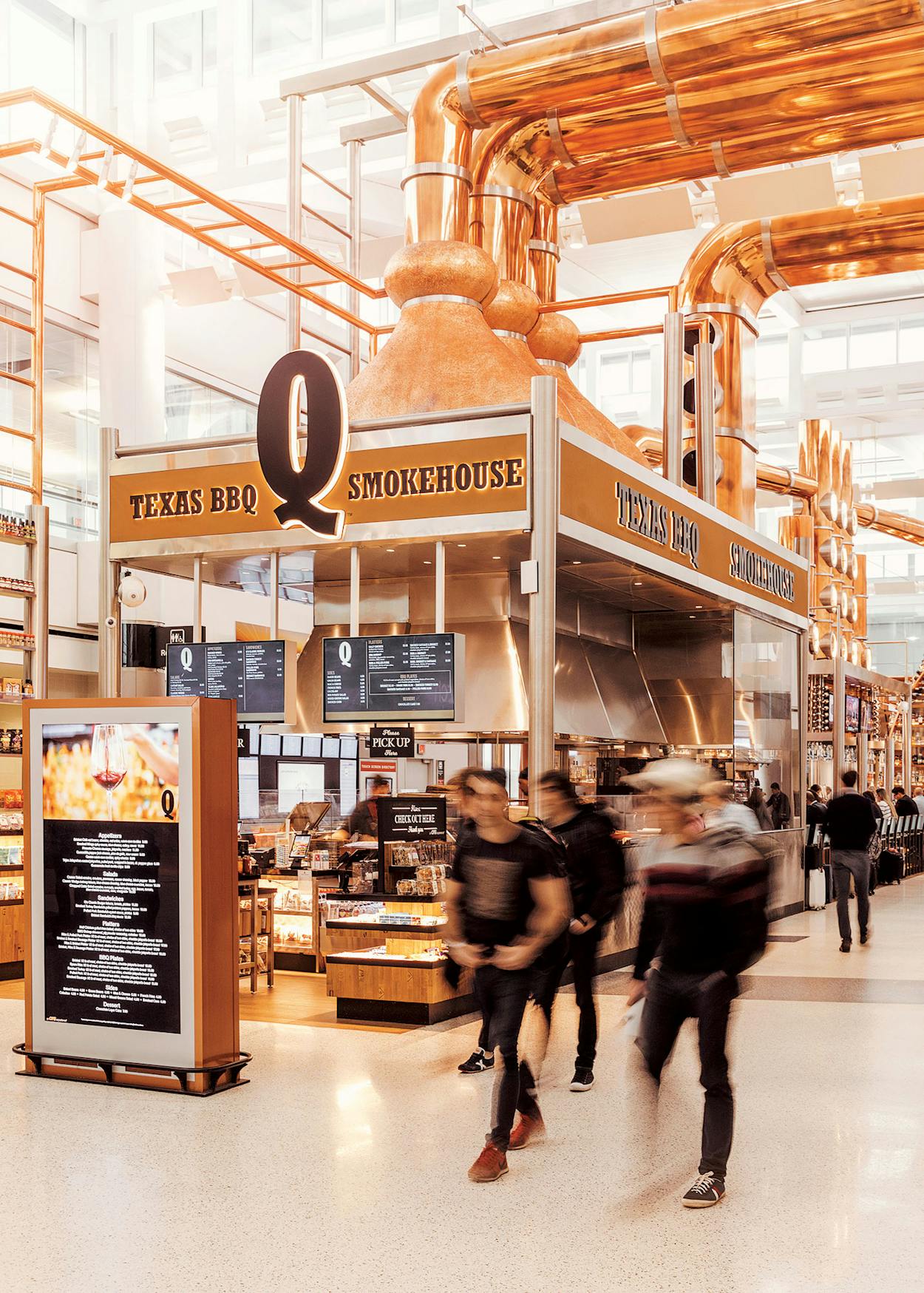A fire is burning in the middle of George Bush Intercontinental Airport in Houston. It never goes out and cannot be left unattended. Thousands of passengers walk past it every day. An elaborate, eye-catching system of copper-clad tubing carries the smoke outside, where it exhausts above the airplanes sitting at their gates. Ramp workers often complain about the smell, but only because it makes them hungry.
That fire is coming from the smokers at Q, the new barbecue joint inside Terminal E. Airport barbecue vendors are nothing new, but they typically smoke the meat off-site, truck it in, and serve it, reheated, to customers who don’t expect much else. Bush is the only place I know of where raw briskets are cooked with burning hardwood.
United Airlines, the largest tenant at Bush, controls development in its terminals. To help run its food and retail concepts, the airline turned to New York–based OTG Management, which designs, builds, and oversees restaurants and stores at airports across the country, with an emphasis on local.
A barbecue joint where the meat is cooked on-site was OTG’s idea. (I should point out that Q isn’t the only Bush vendor smoking barbecue on the premises. Ray’s BBQ Shack, which opened in 2016 in Terminal B, uses a smoker tucked in the back that exhausts straight up through the roof. Sometimes the “only in Texas” cliché is wholly appropriate.)
I asked Eric Brinker, OTG’s vice president of experience, whether the expense and hassle of burning two cords of wood a week at Q was worth it. His answer: absolutely. Otherwise, he says, “[Bush would] be just like every other airport.”
With the hope of pulling off a quality joint, OTG paired up with pitmaster Greg Gatlin, of Gatlin’s BBQ, who brings name recognition and expertise as a well-respected barbecue cook. But Gatlin, who serves as a consultant for this concept, didn’t provide his own recipes (not even the dirty rice, sadly). Instead, he worked with OTG chef Dan O’Donnell on the finer points of smoking ribs, turkey, chicken, sausage, and, of course, brisket.
At first, Gatlin wasn’t certain he wanted his name associated with airport barbecue. “I knew they were sincere, but I didn’t know if they knew what it took,” he says of OTG. But their plan to smoke the meat on-site sold it for him.
Keeping platters of brisket and ribs available for thirteen hours a day or more isn’t easy, but none of the employees want to tell the cranky traveling public that they’re sold out.
O’Donnell is in charge of all the OTG restaurants at Bush, but Q presents some unusual challenges. Because a conflagration at an international airport isn’t a risk anyone is willing to take, someone has to watch the fire overnight, which makes for a pretty lonely shift after the last flights depart, usually around midnight (although OTG says Q will stay open if flights are delayed).
Because of security measures, the Q crew also has to work with rarely sharpened knives that are tethered to the tables in the kitchen. So don’t blame the chefs if the brisket isn’t expertly sliced. (When I noted that the restaurant should have claimed that as an homage to the old days at Lockhart’s Kreuz Market, when communal knives were chained to the dining counters, the kitchen staff didn’t seem to get the joke.)
The biggest challenge, however, is Q’s long hours. Breakfast begins at five in the morning, and the full barbecue menu runs from eleven until the last flights go out. Keeping platters of brisket and ribs available for thirteen hours a day or more isn’t easy, but none of the employees want to tell the cranky traveling public that they’re sold out.
My first meal at Q was arranged and paid for by United and OTG, and I was surrounded by reps from both. Gatlin sat to my left as we sampled smoked pork-stuffed jalapeños wrapped in perfectly crisp bacon, smoked pecans that belong in the bar-food hall of fame, and a few of the cocktails on the menu. After a jalapeño margarita and a bourbon-peach sweet tea, it was time for the barbecue platter. The trio of brisket, ribs, and jalapeño sausage was the best barbecue I’d ever eaten in an airport.
A couple of weeks later, I booked a flight into Houston on another airline. Upon arrival, I had one so-so order of brisket and ribs to go. Breakfast the next day paired cold scrambled eggs with dry brisket. To be fair, I punched the order into a bar-mounted iPad and swiped my credit card just two minutes under the 11 a.m. cutoff for breakfast. O’Donnell said that’s the busiest time of the day for the kitchen, with last-minute breakfast tickets (like mine) coming in just as the lunch rush begins and the menu switches over to display the full selection of barbecue platters.
Lunch, an hour later, was more promising. The juicy lean brisket still had a well-rendered fat cap, and the fatty slice was even better; the ribs were a bit tough. But even with its issues, this was the second-best barbecue meal I’d had at an airport.
Consistent barbecue is hard to pull off on either side of the TSA checkpoint. Your mileage may vary at Q, but the joint’s considerable effort should be commended, and impressive barbecue is certainly a possibility. Just to be safe, add a sack of smoked pecans to your order. It’ll improve any flight.









